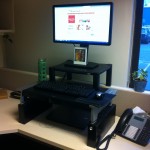A few years ago, I wrote about using a standing desk for the first time. I’d like to provide an update, especially since I’ve continued the practice for quite some time now.
When I started working at my last job, the furniture in my office was set up for an entirely different type of department, so I was lucky enough to be able choose all of my own furniture. I’d already seen another colleague at his own makeshift standing desk and decided to give it a go.
When I started working at my current job in 2013, office spaces were being remodeled and re-purposed and, coincidentally, there wasn’t even a spare chair for me, so I took that as an opportunity to pull together some materials for a standing desk.
You can see that the set-up is pretty basic – it even cost less than buying a new chair! I stand all day; the desk isn’t adjustable and I haven’t asked my employer to buy another chair.
I have plenty of opportunities to sit, though: in meetings, at lunch, even just leaning on my desk when people come by to talk. I know that if I had a chair, or even a stool, I’d be too tempted to sit.
So, with three years of practice under my belt, here are some tips for making this arrangement work.
Making a Standing Desk Work
Standing Desk Height
Get the height of every part of the desk (keyboard, mouse pad, and monitor) correct and comfortable. It helps to have a colleague who’s familiar with ergonomic standards look at your stance while at the standing desk and provide feedback.
A Quality Mat
Invest in a quality floor mat. Mine is industrial strength and about medium firmness, although I’ve tried firmer and softer mats. I’ve found that the “comfortable” (as in, squishy) mats may seem great at first, but in practice don’t provide enough support. You’re looking for more support than comfort when it comes to your mat.
Move Around
Move around constantly. Just as it’s not healthy to sit all day, it’s not healthy to stand all day either. I move, lean, rock, rotate, pace, and do all kinds of other small movements to take the pressure off my feet.
Stick With It (Or Not)
Stick with the process, but find a balance. If you’re not used to standing all day, the transition could hurt, literally. Read about the aches and pains I went through in my first month at a standing desk. But, after that first month, the pain went away. Decide (or consult with a doctor or chiropractor) if you’re up for standing all day. Many people aren’t and that’s okay. Get a movable desk (one that goes up and down, allowing you to sit or stand) and commit to certain periods of time when you’ll stand.
Life with a Standing Desk
The interesting part of this experiment was the realization that sitting makes me feel awful. When I’m in meetings all day – even if they’re fun meetings! – I feel more lethargic afterwards. Even at home, I can feel my circulation get worse while I sit throughout the evening.
It’s clear to me that the natural state for humans is movement.
Have you thought about getting a standing desk? Or do you already have one? What do you think?

